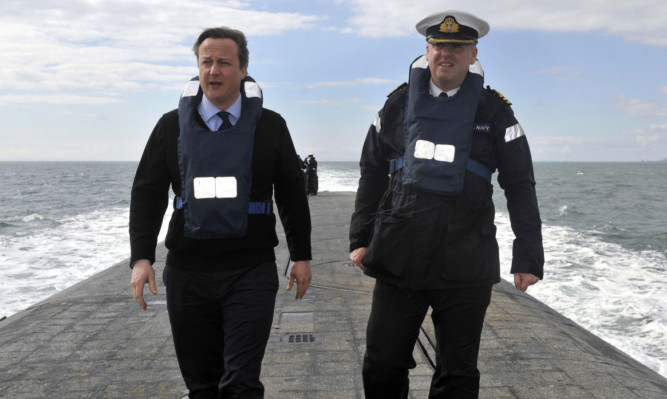David Cameron outlined his argument for the renewal of the Trident nuclear deterrent by claiming there is “real concern” North Korea could pose a threat to the UK.
The Prime Minister said the actions of Kim Jong Un’s regime were “worrying and threatening” and that North Korea had “extremely dangerous” weapons that could potentially target the UK.
Recent polls have shown the majority of Scots appear to back the removal of the nuclear facility from Scotland’s west coast, with the SNP pledging its decommissioning if the country votes for independence next year.
However, the same polls show Trident is low on the list of people’s priorities.
However, Mr Cameron said maintaining the UK’s nuclear capacity was a necessary “insurance policy against the risks that there are in the world”.
During a question and answer session with staff at Thales UK in Glasgow, who design and manufacture defence equipment, the Prime Minister called for North Korea to abide by the United Nations resolution and ensure “the heat is taken out” of the situation.
He said: “North Korea does now have missile technology that is able to reach, as they put it, the whole of the United States.
“If they are able to reach the whole of the United States they can reach Europe too, they can reach us too. That is a real concern.”
Tensions on the Korean peninsula have heightened in recent weeks following a string of aggressive moves by the administration in Pyongyang.
North Korea’s military has warned it has been authorised to attack the US using “smaller, lighter and diversified” nuclear weapons and reports suggest a missile with “considerable range” has been moved to the country’s east coast.
The United States has announced that it will deploy a missile defence system to the US Pacific territory of Guam to strengthen regional protection against a possible attack.
Japan is also said to be concerned about the developments.
Mr Cameron said people should be questioning what the capabilities of countries like North Korea will be in the coming decades and claimed he has not seen anything “better or more cost effective” than the current nuclear deterrent.
Scotland’s Deputy First Minister, Nicola Sturgeon, claimed the UK Government was “out of touch” with the priorities of people across Scotland.
She said: “Trident isn’t the answer to the threats we face as a country. It diverts resources from conventional defence which in Scotland has faced disproportionate cuts by successive UK governments and the vast amounts of money spent on Trident and its replacement would be far better spent on other priorities.
“Furthermore, all of the available evidence including votes in our own Parliament point to the people of Scotland being utterly opposed to nuclear weapons being based here.
“We are pledged to get rid of Trident, and only an independent Scotland will be able to do so.
“However, the Scottish Government is clear in its intention to retain Faslane as a conventional naval base and joint forces HQ, therefore guaranteeing that it will play a key role in ensuring that Scotland is properly defended.”
